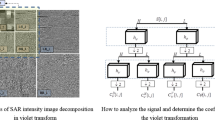Abstract
As the amount of data produced by ground penetrating radar (GPR) for roots is large, the transmission and the storage of data consumes great resources. To alleviate this problem, we propose here a root imaging algorithm using chaotic particle swarm optimal (CPSO) compressed sensing based on GPR data according to the sparsity of root space. Radar data are decomposed, observed, measured and represented in sparse manner, so roots image can be reconstructed with limited data. Firstly, radar signal measurement and sparse representation are implemented, and the solution space is established by wavelet basis and Gauss random matrix; secondly, the matching function is considered as the fitness function, and the best fitness value is found by a PSO algorithm; then, a chaotic search was used to obtain the global optimal operator; finally, the root image is reconstructed by the optimal operators. A-scan data, B-scan data, and complex data from American GSSI GPR is used, respectively, in the experimental test. For B-scan data, the computation time was reduced 60 % and PSNR was improved 5.539 dB; for actual root data imaging, the reconstruction PSNR was 26.300 dB, and total computation time was only 67.210 s. The CPSO-OMP algorithm overcomes the problem of local optimum trapping and comprehensively enhances the precision during reconstruction.







Similar content being viewed by others
References
Bai X, Ji YC, Fang GY (2011) Studies on simulation technique of tree single root imaging by ground penetrating radar. J Agric Sci Technol 13(1):129–136
Borden KA, Isaac ME, Thevathasan NV, Gordon AM, Thomas SC (2014) Estimating coarse root biomass with ground penetrating radar in a tree-based intercropping system. Agrofor Syst 88(4):657–669
Bourgeois JR, Smith GS (1996) A fully three-dimensional simulation of a ground-penetrating radar: FDTD theory compared with experiment. IEEE Trans Geosci Remote Sens 34(1):36–44
Candes E (2006) Compressive sampling. In: Proceedings of the International Congress of Mathematicians, vol 3, pp 1433–1452
Cui XH, Chen J, Guan LL (2009) The application of ground penetrating radar to plant root system detection. Adv Earth Sci 24(6):606–611
Cui XH, Chen J, Shen JS, Cao X, Chen XH, Zhu X (2011) Modeling tree root diameter and biomass by ground-penetrating radar. Sci China Earth Sci 54(5):711–719
Dentith M, O’Neill A, Clark D (2010) Ground penetrating radar as a means of studying palaeofault scarps in a deeply weathered terrain, southwestern Australia. J Appl Geophys 72(2):92–101
Donoho D (2006) Compressed sensing. IEEE Trans Inf Theory 52(4):1289–1300
Guo LN, Wen XB (2014) SAR image compression and reconstruction based on compressed sensing. J Inf Comput Sci 11(2):573–579
Guo L, Cui XH, Chen J (2012) Sensitive factors analysis in using gpr for detecting plant roots based on forward modeling. Prog Geophys 27(4):1754–1763
Guo L, Fan BH, Wu Y, Li WT, Cui XH, Chen J (2014) A review on the application of ground-penetrating radar to detect and quantify coarse roots. China Sci 9(4):494–498
Gurbuz AC, Mc Clellan JH, Scott WR (2009) A compressive sensing data acquisition and imaging method for stepped frequency GPRs. IEEE Trans Signal Process 57(7):2640–2650
Isaac ME, Anglaaere LCN (2013) An in situ approach to detect tree root ecology: linking ground-penetrating radar imaging to isotope-derived water acquisition zones. Ecol Evol 3(5):1330–1339
Lai NN, Yuan CJ, Tang S, Yang J, Zhao J, Zhang WJ (2011) Application of ground-penetrating radar to detection of root system distribution of a veteran tree. J of Northeast For Univ 39(11):124–126
Lu CW, Liu XJ, Fang GY (2011) Compressive sensing for GPR data acquisition. Acta Electron Sin 39(9):2204–2206
Qu LL, Huang Q, Fang GY (2010) Stepped frequency ground penetrating radar imaging algorithm based on compressed sensing. Syst Eng Electron 32(2):295–297
Raz-Yaseef N, Koteen L, Baldocchi DD (2013) Coarse root distribution of a semi-arid oak savanna estimated with ground penetrating radar. J Geophys Res 118(1):135–147
Song LP, Liu QH, Li FH, Zhang ZQ (2005) Reconstruction of three-dimensional objects in layered media: numerical experiments. IEEE Trans Antennas Propag 53(4):1556–1561
Tanikawa T, Hirano Y, Dannoura M, Yamase K, Aono K, Ishii M, Igarashi T, Ikeno H, Kanazawa Y (2013) Root orientation can affect detection accuracy of ground-penetrating radar. Plant Soil 373(1–2):317–327
Tripp Barba C, Urquiza Aguiar L, Aguilar Igartua M (2013) Design and evaluation of gbsr-b, an improvement of gpsr for vanets. Lat Am Trans IEEE 11(4):1083–1089
Wu Y, Guo L, Cui X, Chen J, Cao X, Lin H (2014) Ground-penetrating radar-based automatic reconstruction of three-dimensional coarse root system architecture. Plant Soil 383(1–2):155–172
Xu XB, Zheng KF, Li D, Bin WuB, Yang YX (2012) New chaos-particle swarm optimization algorithm. J Commun 33(1):16–24
Yang JG, Jin T, Huang XT, Thompson J (2014) Sparse mimo array forward-looking gpr imaging based on compressed sensing in clutter environment. IEEE Trans Geosci Remote Sens 52(7):4480–4494
Yin AH, Jiang HM, Zhang QM (2014) Application of improved bomp algorithm in face recognition. Comput Eng Appl 38(12):275–278
Zhang WH, Zhou T, Huang BX (2014) Outlier deletion based improvement on the stomp algorithm for sparse solution of large-scale underdetermined problems. Sci China Inf Sci 57(9):1–14
Zhu SP, Huang CL, Su Y, Motoyuki S (2014) 3d ground penetrating radar to detect tree roots and estimate root biomass in the field. Remote Sens 6(6):5754–5773
Author information
Authors and Affiliations
Corresponding author
Additional information
Project funding
This study was supported by the Fundamental Research Funds for the Central Universities (DL13BB21), the Natural Science Foundation of Heilongjiang Province (C2015054), Heilongjiang Province Technology Foundation for Selected Osverseas Chinese, and Natural Science Foundation of Heilongjiang Province (F2015036).
The online version is available at http://www.springerlink.com
Corresponding editor: Yu Lei
Rights and permissions
About this article
Cite this article
Li, C., Su, Y., Zhang, Y. et al. Root imaging from ground penetrating radar data by CPSO-OMP compressed sensing. J. For. Res. 28, 155–162 (2017). https://doi.org/10.1007/s11676-016-0284-4
Received:
Accepted:
Published:
Issue Date:
DOI: https://doi.org/10.1007/s11676-016-0284-4




